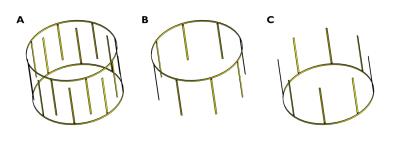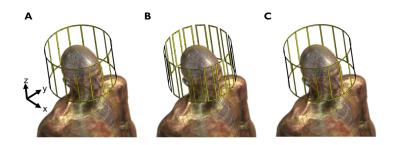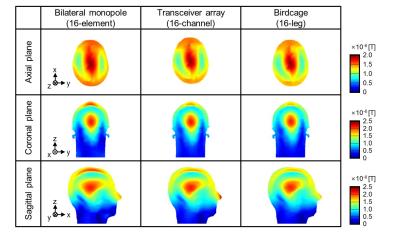4404
A Feasibility Study on Bilateral Monopole Antenna with Two Common Grounds for 7T MRI1Department of Health Sciences and Technology, Gachon University, Incheon, Korea, Republic of, 2Neuroscience Research Institute, Gachon University, Incheon, Korea, Republic of, 3Department of Biomedical engineering, Gachon University, Incheon, Korea, Republic of
Synopsis
In this study, a bilateral monopole antenna was proposed to have ring element of existing ring-monopole as common ground and to consist of two interlocking monopole antennas along z-axis to improve lopsided |B1| field toward the ground plate. Geometry of the proposed bilateral monopole antenna was optimized with EM simulation then optimized antenna was compared with a transceiver array coil and a birdcage coil for quality verification. Even with worse power consumption, the proposed bilateral monopole antenna can be an alternative for existing RF coils such as transceiver array coil and birdcage coil due to its improved |B1+| field uniformity.
Purpose
Plenteous researches on various types of dipole antenna as transmit and receive coil for ultra-high field (UHF) magnetic resonance imaging (MRI) are now being proceeded due to its lower specific absorption rate (SAR) and deeper radiofrequency (RF) penetration depth than a loop surface coil.1 Moreover, asymmetric magnetic flux (|B1|) pattern such as |B1| twisting pattern doesn’t appear at dipole antennas in UHF MR imaging.2-3 Quarter-wavelength monopole antenna was proposed to reduce length of half-wavelength dipole antenna, however sharp RF signal reduction from ground region makes its use limited.4 In this study, ring element of existing ring-monopole antenna was embezzled as common ground and two monopole antennas consist of multiple vertical elements were designed to be interlocked in the opposite direction to improve |B1| uniformity along the z-axis (Figs. 1, 2).Methods
Electromagnetic (EM) calculations were performed with Sim4Life (ZMT, Zurich, Switzerland) by adjusting length of the vertical elements to acquire optimized structure as well as adjusting distance between two antennas at fixed 300mm diameter common ground. The optimized bilateral monopole (16 vertical elements, diameter: 300mm, length: 194mm and length of vertical element: 180mm) was compared with a transceiver array coil (16-channel, diameter: 300mm, length: 194mm and surface coil size: 45×194mm2) and a birdcage volume coil (16-leg band pass type, diameter: 300mm and length: 194mm) in terms of RF transmission (|B1+|) field nonuniformity (NU=100×(SignalMax-SignalMin)/SignalMean) and their power consumption using finite-difference time-domain (FDTD) method (Fig. 3). Operating frequency was set to 297.2MHz, resonance frequency of 1H at 7T, while each vertical element was set to have 22.5° of phase offset for circular polarization. Each |B1+| of three coils at the center was normalized to 1.957μT, the necessity field strength of 90° flip angle in 1H with a 3msec rectangular RF pulse.5 Human phantom (Duke, 34 years, male) was taken up in each coil aligning its brain to the coil center.Results
The power consumption and |B1+| field uniformity showed superior performance as the length of vertical elements increase and the best |B1+| field uniformity could be acquired when the two monopole antennas were 180mm apart from each other. The highest uniformity was shown when the ratio between diameter to coil length is about 0.65 (diameter: 300mm / length: 194mm). Uniformity along the axial (xy-) plane of proposed bilateral monopole antenna was enhanced by 14% than a birdcage coil while uniformity along the sagittal (yz-) plane showed 16% improvement than transceiver array coil (Figs. 4, 5).Discussion
Existing monopole antennas have a disadvantage showing lopsided |B1| field toward the ground plate. In this study, loop-shaped ring ground was proposed to be an alternative for the ordinary ground plate. And a modified monopole antenna was placed upside-down to another monopole antenna forming birdcage look like shape. The bilateral monopole antenna having longest pole length showed the best uniformity and the least power consumption.Conclusion
The proposed bilateral monopole antenna consists of two monopole antennas along the z-direction and each monopole antenna is composed with more than two vertical elements along the x-direction. These figures can facilitate fast imaging by using the parallel imaging method. Even with worse power consumption, the proposed bilateral monopole antenna can be an alternative for existing RF coils such as transceiver array coil and birdcage coil due to its improved |B1+| field uniformity and relatively easy construction.Acknowledgements
This work was supported by a National Research Foundation of Korea (NRF) grant funded by the Ministry of Education, Science and Technology of the Republic of Korea (grant number: NRF-2014M3C7033998), and a grant from the Korea Health Technology R&D Project through the Korea Health Industry Development Institute (KHIDI), funded by the Ministry of Health and Welfare of the Republic of Korea (grant number: HI14C1135).References
1. Raaijmakers AJE, et al. Dipole antennas for ultrahigh-field body imaging: a comparison with loop coils. NMR in Biomedicine 2015.
2. Vaidya MV, et al. Dependence of B1- and B1+ field patterns of surface coils on the electrical properties of the sample and the MR operating frequency. Concepts in Magnetic Resonance Part B: Magnetic Resonance Engineering 2016.
3. Zhang B, et al. Why Does the Radiative Antenna Have no B1 Twisting at 7T? Framework for and Applications of a Conceptual “Mirror Current: Model of Coil-Tissue Interactions. Proc Intl Soc Mag Reson Med 2012:p2816.
4. Hong SM, et al. New design concept of monopole antenna array for UHF 7T MRI. Magnetic resonance in medicine 2014;71.5:1944-1952. 5. Collins CM, at al. Calculations of B1 distribution, SNR, and SAR for a surface coil adjacent to an anatomically-accurate human body model. Magnetic resonance in medicine 2001;45.4:692-699.
5. Collins CM, at al. Calculations of B1 distribution, SNR, and SAR for a surface coil adjacent to an anatomically-accurate human body model. Magnetic resonance in medicine 2001;45.4:692-699.
Figures




